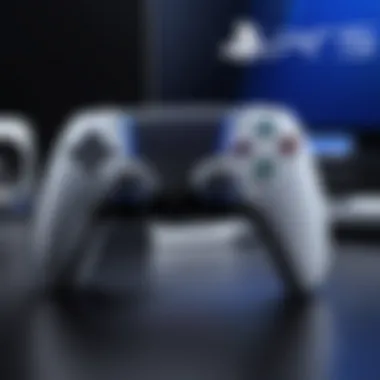Understanding PS5 Console Pricing: Factors and Insights


Preface to PS5 Pricing
Understanding the pricing of the PlayStation 5 console is essential for both potential buyers and industry analysts. The pricing structure significantly affects consumer decision-making. Exploring the price point helps to elaborate on buyer expectations, perceived value, and subsequently, market dynamics. This analysis emphasizes the relevance of cost, given the PS5's features and technological advancements.
Overview of the PS5 Console
The PlayStation 5, Sony's flagship gaming console, launched with two versions: the standard edition at $499 and a digital edition at $399. It boasts cutting-edge technology, a custom SSD for faster load times, and a powerful GPU capable of 4K gaming. This device aims to elevate the gaming experience with its Immersive graphics and advanced haptic feedback.
Amidst various competitors, the PS5 stands out not only due to its brand reputation but also thanks to its exclusive game titles. Understanding its specifications gives insight into its pricing values. However, simply knowing the specs is not enough. One must analyze its pricing rationale in the context of both consumer expectations and external market forces.
Initial Pricing Context
When launched in November 2020, the PlayStation 5's pricing sparked significant conversation among gaming communities. At initial release, various market segments debated the affordability and value provided by it. Sony positioned the PS5 against up-and-coming competitors while accounting for material costs and development expenses.
Factors that influenced the initial price included:
- Production resources, including silicon and chip shortages
- Competitor activity in the broader gaming industry spectrum, notably the Xbox Series X with a similar pricing strategy
- The pandemic’s consequence on the global supply chain
Understanding this pricing context is critical. It not only reveals the strategic approaches to distributing the PS5 but also contextualizes buyer insights about console value. Hence, grasping these initial pricing strategies lays groundwork for indepth analysis into further discussions on factors affecting PS5 pricing.
Factors Influencing Console Pricing
The pricing of the PlayStation 5 is not just a number; it reflects various crucial elements that determine how much consumers will pay. A profound understanding of the factors influencing console pricing provides insights into whether the $499 tag meets consumer expectations and market dynamic. This section aims to explain these important facets while contemplating the implications they carry for the consumer.
Technological Advancements
Technology plays a pivotal role when discussing console pricing. The PS5 integrates high-end gaming hardware, like its custom AMD CPU and GPU, which offer rapid load times and enhanced graphics.
- Key technological features include:
- Ray Tracing: It gives more realistic lighting effects and shadows.
- SSD Storage: Reduces load times significantly, improving user experience.
Those advancements do not just elevate gaming but increment the production costs. The intricate components involve sophisticated engineering, hence raising the retail price.
In delivering cutting-edge technology, the PS5 also attempts to future-proof investments for buyers by ensuring compatibility with advanced gaming features aimed for longer terms usage.
Manufacturing Costs
Manufacturing plays an undeniable part in establishing the price of the PS5. Numerous factors come into play during this stage, affecting overall costs.
- Component Costs: Prices for chips and other relevant components can fluctuate often, affecting production budgets.
- Production Scale: The number of units being produced impacts manufacturing efficiency. Large batch production tends to lower costs per unit.
- Logistics and Distribution: The expenses involved in transporting the PS5 from factories to retailers also factor in.
Given these considerations, PS5 pricing not only considers initial construction but accounts for the materialize and market changes as well.
Market Demand and Supply
Market forces also create significant effects on console costs through demand and supply. Once PS5 launched, they observe criteria establishing buyer typicality:
- High Demand: The initial madness around PS5 had societies eager to adopt; hence, customer enthusiasm can hike prices.
- Limited Supply: Disruption in supply chains, especially material shortages during recent years, exacerbated the scarcity, creating conditions for scalping and higher sale prices-Many waited months to get their unit.
Understanding the interplay between demand and supply can demystify consumer pressures and learn when to purchase for ‘been-the-right-time’ transactions.


As seen with the PS5, higher demand accompanied by low availability can battle against price stabilization, commonly skewing costs higher.
In reaching a broad understanding of these factors—technological advancements, manufacturing efficiency, and market dynamics—savvy consumers can better navigate their gaming console decisions and expectations. Thus, recognizing these features fortifies their comprehension toward the great value the PS5 presents or conveys to theorized gaming effeciency.
PS5 Pricing and Market Trends
In the realm of gaming consoles, the pricing structure is not merely an arbitrary figure; it speaks volumes about market forces, consumer behavior, and brand strategy. Understanding PS5 pricing and market trends provides valuable insights into how these elements interact and influence one another. Pricing affects demand, and the manner in which consumers perceive value can inform the overall success of the console.
Current Market Landscape
The current gaming market is characterized by intense competition and fluctuating consumer interests. As more players enter the market, pricing strategies become crucial for maintaining market share. Both established brands and new entrants must carefully delineate their pricing tactics to attract consumers while achieving profitability.
A notable trend is the increased hybridization of gaming platforms. More consumers are seeking devices that offer seamless cross-platform experiences. Factors like game libraries, subscriptions, and exclusive content can shape perceptions about value. For instance, the PlayStation 5's extensive library bolstered by exclusive titles can justufy its price tag.
With units selling at the original MSRP of $499 over extended periods despite high demand and scarcity, a calculation of both overall arrival prices through various channels emerges. Retailers often arrive at these numbers based on production costs, market demand, and competitive pressures, leading to variable pricing across stores.
Competitor Pricing Strategies
Sony's PS5 competes closely with other industry giants such as Microsoft’s Xbox Series X. Most computers in this arena seek distinct market positions while grappling with established sentiments and brand loyalty among consumers.
Microsoft adopted services and subscription strategies. The Xbox Game Pass gives consumers access to a broad range of games for a monthly rate, increasing perceived value without shocking hash pricing. Conversely, Sony relies on powerful exclusive titles that elevate the value perception of their hardware in various markets.
Assessing competitor pricing strategies allows for a reflective understanding between price and perceived value. A comprehensive comparison of what alternatives charge often reveals nuances among performance and consumer acceptance.
Data shows that gaming console offerings don't exist in a vacuum; they must reflect broader economic conditions and consumer sentiments.
As the console lifecycle unfolds, both competitors may adjust their initial strategies based on real-time feedback and changing user expectations, amplifying or reducing their price points as necessary while ensuring they do remains competitive in dynamic climate.
Examining how competitor pricing affects consumer choices sheds light on PS5's stability within rapidly rotating markets. Both consumer behavior and pricing reveal a complex relationship deserving further exploration — continuous cycles of trends worth closely monitoring.
Analyzing the $499 Price Tag
The $499 price tag of the PlayStation 5 console represents more than just a fixed number. It integrates various elements including technology, market dynamics, and consumer expectations. Understanding this price requires an exploration of why it has been set at this point and what it really means for potential buyers and the gaming industry overall. Knowing the nuances behind this pricing can help consumers discern the console's true value and gauge if this investment is fitting based on their gaming habits and preferences.
Arguments for Value
When assessing the PlayStation 5 at its $499 price, one must consider several compelling points that underline its value:
- Innovative Technology: The PS5 boasts cutting-edge technology. It offers super-fast load times, advanced graphic capabilities, and formations like ray tracing. These features enhance both the visual experience and gameplay smoothness.
- Diverse Game Library: The console supports a large selection of games, including exclusives such as Demon's Souls, Ratchet & Clank: Rift Apart, and Spider-Man: Miles Morales. These exclusive titles can be considered crucial, as they add depth to the investment by offering unique gaming experiences not found elsewhere.
- User Experience Enhancements: With its DualSense controller, the PS5 enhances user experience through haptic feedback and adaptive triggers. These features engage players on a deeper level, augmenting the sense of realism in games.
- Launched Competitive Pricing: In comparison to rivals such as Microsoft’s Xbox Series X, which also sells for $499, the price feels relevant in a competitive landscape where consumers may prioritize the features offered relative to the cost.
- Future-proofing Investments: The PS5 aims to maintain its relevance for years with backward compatibility and anticipated upcoming titles. Buyers may feel at ease with the thought that their investment would still hold value as technology progresses.
The features and functionalities associated with the PS5 outline its inherent value, suggesting that $499 is more than a sticker price but rather a reflection of thoughtful engineering.
Critiques of Pricing
Despite the advantages, some critiques related to the $499 pricing surface:
- Affordability Concerns: The common perspective remains that $499 might exclude a portion of gamers struggling with pricing, particularly when entering the gaming sphere. Youth and economically constrained families may find this Presidential succession a less-accessible option.
- Comparison Failings with Other Consoles: Contrasting to lower-cost alternatives like the Nintendo Switch or the Xbox Series S, the PlayStation 5 faces scrutiny regarding whether it offers enough unique features to justify the nearly double price of the Series S, ultimately leading several to hesitate.
- Availability and Price Inflation: Ongoing issues with supply shortage led to price inflation both in resale and retail markets. Consumers sometimes encounter scarcity or inflated prices, raising concerns over the core pricing strategy employed by manufacturers and retailers.
- Uncertainty surrounding content: Some gamers critique whether AAA titles Released upon launch cater enough diversity to make the console a worthwhile selection right out of the box, making time-of-purchase damaging.
- Secondary Market Concerns: The growing prevalence of the secondary market, with players attempting to resell their consoles for elevated prices, introduces a conversation surrounding perceived worth and true consumer sentiment.
Conclusively, evaluating the PS5 pricing tag requires a nuanced approach highlighting layers of anticipated value, while simultaneous critiques must also be recognized. Such analysis can map to informed choices regarding PS5 as both an innovative gadget and an economical consideration.
Comparative Analysis with Competitors


Comparing the PlayStation 5 pricing strategy with competitors provides crucial insights into consumer choices in a saturated market. The examination illuminates how the pricing aligns with both features and market positioning among similar products. Understanding where the PS5 stands in relation to its immediate rival, the Xbox Series X, as well as other alternatives, enhances comprehension of its actual value. This section underscores the merits of choosing one device over others.
Xbox Series Comparison
When looking at the PlayStation 5, we cannot ignore the reputation and offerings of the Xbox Series X. Both of these consoles currently are priced at $499, creating a direct point of comparison for consumers. The Xbox Series X boasts similar hardware capabilities, operating at 120 FPS and supporting up to 8K gaming, much like its Sony counterparts. However, a few aspects differentiate these consoles:
- Exclusive Titles: Sony has a rich library of acclaimed exclusive games. Titles such as Demon's Souls and Ratchet & Clank: Rift Apart enhance its desirability. In contrast, Xbox franchises like Halo and Gears of War attract a different segment of gamers, emphasizing a community-driven experience.
- User Interface: The PS5’s menu organization differs from the Xbox’s dashboard. While preferences vary among users, PS5’s approach appeals to those seeking a futuristic feel. Xbox users might prefer a familiar grounding with their past consoles.
- Subscription Services: Xbox Game Pass is a significant draw for many gamers with a wide array of titles available. PlayStation offers its own service, but pricing and game selections often differ between the two, impacting long-term cost evaluation for consumers.
Conclusively, the comparison between PS5 and Xbox Series X reveals a nuanced landscape. Decisions will hinge not just on pricing, but on personal preferences surrounding game exclusives and additional subscription options.
Other Market Alternatives
While the PS5 and the Xbox Series X dominate conversations around console gaming, multiple alternatives exist that cannot be overlooked. Understanding these others adds further context to potential PS5 buyers.
- Nintendo Switch: The Nintendo Switch is priced differently, generally lower starting around $299. It's mobility and a unique gaming experience cater to different demographics. Gamers eliciting portable gaming desires find value in the Nintendo platform that five-star graphics may not cover.
- PC Gaming: Gaming PCs present another counterpart. Prices can widely differ, with entry-level rigs starting at a lower price than both consoles, depending on performance capabilities. Such options appeal to dedicated gamers who desire upgradability and an expansive library of games through platforms like Steam.
- Cloud Gaming Services: Platforms such as Google Stadia and NVIDIA GeForce Now shift the paradigm toward a less hardware-intensive path of gaming enjoyment. These services broadly target players looking to minimize their upfront costs. Therefore, the PC uproots conversations around console pricing, as there's an ongoing trend toward digital services.
The inclusion of these alternative systems equips consumers with a full sense of their choices, drawing them directly into their lifestyles and gaming habits. Having various mechanisms can even lead to considerations of total cost valued by consumers studying how to engage gaming effectively.
When comparing PlayStation 5 with competitors, it is essential to view each option holistically. Consider not only the upfront pricing but the long-term value brought by software libraries, accessories, and feature set.
Consumer Perceptions of Value
Understanding consumer perceptions of value related to the PlayStation 5 is crucial for assessing how potential buyers view this gaming console. Factors influencing these perceptions include price, features, brand loyalty, and the overall gaming experience promised by PS5. Analyzing how consumers assess worth shapes both marketing strategies and pricing models for game consoles.
When individuals consider the PS5 at its $499 price tag, various aspects come into play. High customizing options, exclusive game titles, and the ongoing software support are among the benefits that enhance perceived value. Tech-savvy consumers often engage in thorough research, discussing the capabilities of the console on platforms like Reddit or Facebook, sharing their findings and insights.
There are many considerations for understanding consumer value. First, does the performance match the expectations set by performance indicators and marketing hype? Secondly, how significant are first-party titles in buyer decision-making? These nuances guide not just individual purchasing choices but also inform Sony's ongoing features and services planning.
To further evaluate the perceptions of value, insights into user feedback and reviews yield tangible recommendations for improvement and satisfaction enhancements.
Exploring these perceptions helps in identifying consumer priorities and analyzing long-term trends, contributing to broader understandings this market. From further feature expansions to price adjustments that could make the console more accessible, factors informed by consumer feedback indisputably shape the evolution of the PS5 in the competitive landscape.
User Feedback and Reviews
User feedback is paramount in dissecting how well the PS5 meets consumer expectations. An assortment of reviews gives insights into real-world use. Based on customer feedback, the lightning-fast load times, stunning graphics, and user-friendly interface tend to receive high praise. This affirmation can ultimately validate the console's price.
However, negative reviews focus on limited stock issues or false expectations regarding the backward compatibility of some games. Discrepancies in experience can deter buyers who might perceive the cost as unjustifiable if the anticipated features do not live up to marketed claims.
Key Feedback Takeaways
- Positive:
- Negative:
- Exceptional loading times enhance overall user satisfaction.
- A robust library of exclusive titles justifies some of the cost.
- Limited availability can frustrate potential buyers.
- Some users report dissatisfaction with narrow backward compatibility.
Despite occasional criticisms, peer recommendations particularly impact new buyers, who often turn to online forums for clarifications and validation of their thoughts on value.
Impact of Marketing on Consumer Choices
Marketing plays a substantial role in how potential customers perceive the value of the PS5. Promotional campaigns highlight the powerful hardware and game-exclusive benefits, drawing attention to what sets the console apart from its competitors. Often, marketing influences whether individuals feel that $499 is a justified investment for a gaming device.


The emphasis on features such as ray tracing, integrated social sharing tools, and enhanced performance over previous generations encourages buyer interest alongside informative campaigns.
Considerations in Marketing Approach
- Target Audience Understanding:
- Building Brand Loyalty:
- Imagery of Exclusivity:
- Successful marketing campaigns tailor messages toward desired consumers primarily interested in high-tech gaming experiences.
- Sony leverages nostalgia and a robust catalog of previous titles to attract lifelong fans.
- Highlighting high-value games exclusive to PS5 captivates the longing for unique gaming content among dedicated players.
Effective marketing instills a sense of desire but articulating clear messaging about what consumers get for their investment remains essential. The shaping of value perception is not accidental but a crafted process reflecting the prevailing conditions and targeted messaging of Sony's marketing team.
Long-term Pricing Predictions
Long-term pricing predictions are crucial for consumers and stakeholders. The gaming industry is uneasy and unpredictable. Understanding how pricing might evolve will guide players and collectors in their decisions.
Why This Matters:
- Investment Value: Predicting price trends can indicate if a PS5 console is a worthy investment. With fluctuating demand, prices may rise or fall significantly over months or years.
- Market Position: Knowledge of potential shifts helps determine where the PS5 stands among its competitors. This impacts buying choices for both gamers and sellers.
- Consumer Strategy: Insight into future price changes allows buyers to create efficient shopping strategies. Waiting for sales or buying early can both offer financial benefits.
By analyzing the factors shaping long-term prices, we pave the way for deeper discussions about expected market shifts and potential adjustments in pricing strategies.
Expected Market Shifts
Anticipated changes in market conditions can significantly influence PS5 prices over time. Key elements to consider include:
- Recession Impacts: Economic downturns can tighten consumer spending. Gamers may delay purchasing new consoles, leading to a decline in demand.
- Technological Advancements: From graphics to online services, improved technology can make older consoles less appealing, pushing down prices for older models.
- Availability Issues: Supply chain disruptions may lead to limited console availability. If severe, this might encourage a price increase due to scarcity.
Thus, fluctuations in economic and technological landscapes, combined with external pressures, will play defining roles in the value of the PS5.
Potential Adjustments in Pricing Strategies
Manufacturers often need to respond to evolving market conditions. Key adjustments may include:
- Bundles and Promotions: Sony could offer promotional deals with games or accessories, creating perceived value while adjusting base prices.
- Limited Editions: Special versions of the PS5 may launch at premium prices, offering exclusivity while shifting mainstream prices lower over time.
- Subscription Models: Future trends may see digital content drive alternatives, reflecting drastic price strategies for the console hardware itself.
These potential changes underscore the fluid nature of the gaming market.
Closure and Recommendations
Summary of Findings
The analysis of the PlayStation 5 console pricing reveals crucial insights into its position in the gaming market. Pricing at $499 is not merely a number, it embodies a complex intersection of technological investment, market dynamics, and consumer expectations. Several key points emerge from the investigation:
- Technological advances largely justify the premium pricing.
- Manufacturing costs impact supply chains and overall pricing strategies.
- Market demand continues to fluctuate based on various factors including holiday seasons and stock availability.
- Consumers display varied perceptions of the titled value with respect to gaming quality and available features.
- Price strategies of competitors like Xbox Series X provide contextual backdrop and further necessitate understanding individual value propositions.
- Overall, while PS5 pricing is anchored by specific cost considerations, potential buyers should weigh brand loyalty, game availability, and long-term value in their purchase decisions.
“Engaging with the pricing landscape of PS5 is essential for informed decision-making and maximizing value in the context of modern gaming.”
Guidance for Potential Buyers
In making a decision to purchase the PlayStation 5, prospective buyers should consider multiple aspects:
- Game Library: The games available for PS5 are critical to the value of the console. Titles exclusive to PlayStation can greatly enhance the experience, making the investment worth it.
- Alternatives on the Market: As previously included in the analysis, there are competitive products offering similar functionalities, for example, the Xbox Series X. Understanding these alternatives can guide the buyer to their optimal choice.
- Future-proofing: Given the evolving technological landscape, contemplate how this console will meet future gaming demands in terms of performance, graphics, and connectivity.
- Budget and Resale Consideration: Enabling allowance for conceivable costs such as controllers or additional games should be part of the budget. Resale value can also change drastically over time, adding another layer to consider.
- Purchase Timing: Prices often fluctuate based on seasonal sales, promotions, and stock updates. Keeping an eye on the market can often land a better price.
Overall, individuals contemplating a purchase of the PS5 should grasp both financial implications and personal gaming goals. This multifaceted approach will assure an educated decision in securing a console that aligns with one's expectations.







